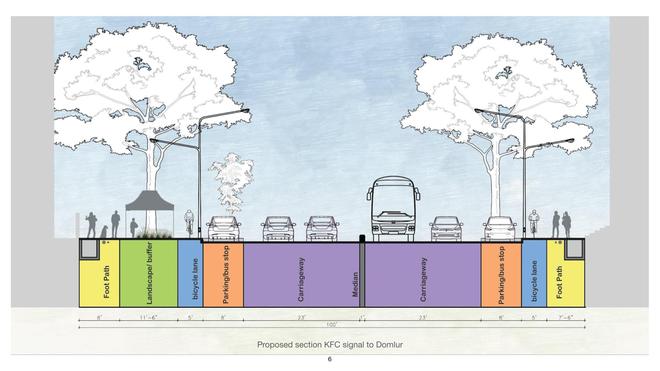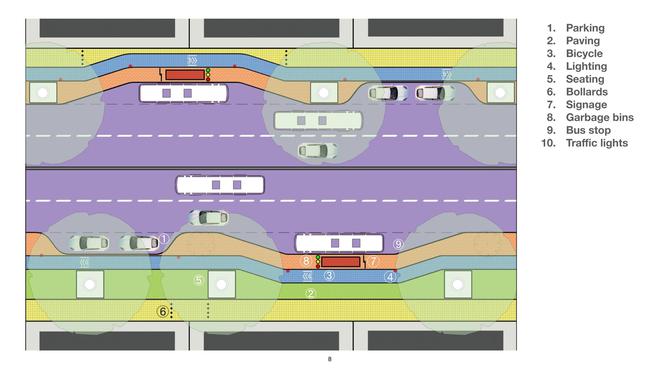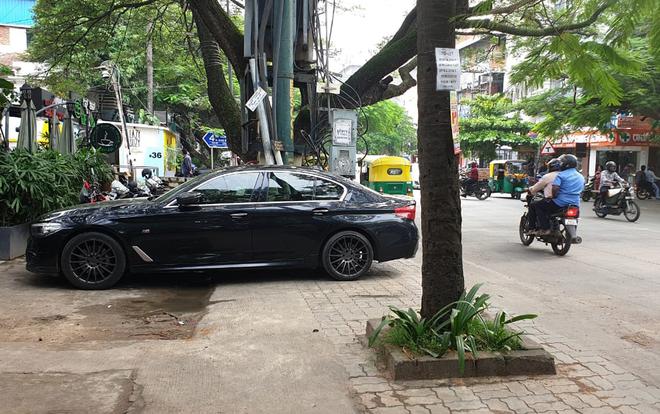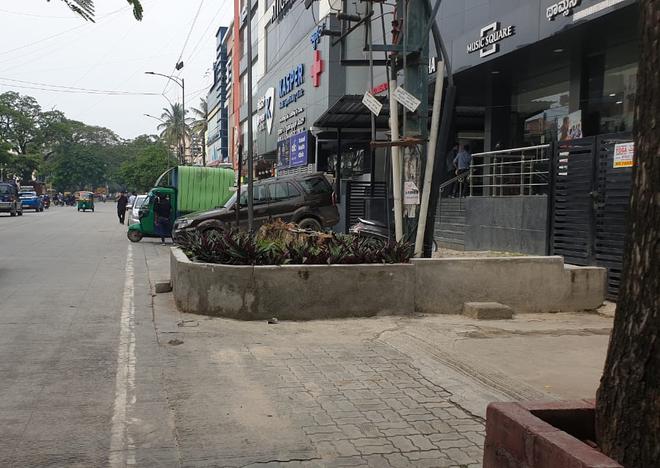Wide, uninterrupted footpaths often beckon walkers in big numbers. But one look at the just upgraded Indiranagar 80 Feet Road and its narrow, discontinuous walking space, and the compromises come out starkly. Along several stretches of this flashy, concretised road, commercial properties have taken over the footpath with sedans and SUVs parked across. Nowhere to go, pedestrians are forced to walk on the road jeopardising their lives.

Guidelines compromised
Is this what the citizen gets after such a costly upgrade? They had high expectations since the Smart City upgrades were modelled after the TenderSURE makeover of St. Mark’s Road, Cunningham Road, Residency Road, and other streets in the city’s heart. Besides walkable footpaths, TenderSURE roads stood out for uniform travel lanes, organised underground utilities contained within the footpath, organised parking and vending, public spaces and landscaping.
The pronounced dilution of the original guidelines had forced a team of architects to step in, as the Indiranagar 100 Ft Road was taken up for a Smart City upgrade. Recalls Sneha Nandihal from the residents collective, IChangeIndiranagar: “A group of our architects had worked with the BBMP on an entire design. A lot of effort was put into it, and we were assured both by the MLA and the Palike that our suggestions would be implemented.”

Much to their disappointment, none of the proposed changes were integrated into the final plan. “The so-called smart city roads are not smart at all. They have a template, and they don’t map it to the particular road. For instance, on 100ft road, they didn’t survey and map it. Instead, since they don’t know the utilities underneath, they are implementing things as they dig. It is a mess,” she says.
Architect inputs ignored
Among the proposals were street furniture, benches, bollards, signage, garbage bins, parking spaces between trees, and a cycling lane. “They said it would cost more to create such lanes. So we said, at least have darker tiles to indicate it is for cycling. Nothing was implemented. Finally, it became a project for us to request them to complete it in whatever form and shape, because so many of our residents were falling,” notes Sneha. Unpaid contracts and transfers of the officials heading the project have only aggravated the delays.
The poor quality of the road surface has been questioned in many other parts of the city as well. For instance, within a year of the upgrade, Miller Road had to be asphalted again. Original designs were compromised to provide parking slots on the footpath. A raised pedestrian crossing was demolished for the project but not restored.

Fixing underground mess
Tender SURE had initiated a whole new way of thinking about streets. While providing an equitable division of the right of way at the surface, it had also looked at fixing the subterranean chaos. The underground utilities were a mess. By building dedicated utility ducts and neatly installing them under the footpath, the Tender SURE roads had put an end to the vicious cycle of cut repair and cut again.
But this unique model has seen deviations. Completed a few months ago, the CMH Road has power lines right in the middle under three feet of concrete, as Sneha points out. “We had been following up with the BBMP to get new lines to be laid under the new footpath. It was all approved, but the funds did not get released because the government changed. Now if something goes wrong, if the line goes faulty, we are all going to be in darkness because the lines are under three feet of concrete.”
Since utility shifting and re-laying of pipelines and cables are a critical part of the upgrade, active coordination of multiple agencies is crucial. She feels, “A project of this kind should have had all agencies working as partners. You can’t have just the BBMP running it. The left hand doesn’t know what the right is doing.”
Lack of detailing
The original set of six Tender SURE roads had the pedestrian at the heart of the planning process. Even bus stops had to be built without affecting the 1.8m wide footpath. “Smart city roads give the impression of work being done without detailing. On St. Mark’s Road, every little detail was known. The property owner knew exactly how the entry and exit were going to work. Without such detailing, you get a shoddy output. Varying pavement heights, entry, exit. So it is not even a uniform walking experience,” says urbanist V. Ravichander, who was part of the earlier road planning process.
Both Tender SURE and Smart City roads were designed to give an alternative vision for pedestrians, who are often compelled to navigate wide and busy roads with insufficient crosswalks. The new models were escape routes particularly for senior citizens and children. Pedestrians account for the bulk of accident fatalities in the city.

People-centric approach
Nikita Luke from the World Resources Institute (WRI) says a people-centric approach to street design prioritizes the safety and convenience of pedestrians and cyclists, making it simpler and more appealing for people to walk or bike. “Achieving this involves creating well-lit sidewalks, secure crosswalks, and dedicated cycling lanes, which encourage active transportation and reduce the reliance on cars,” she elaborates.
Cars being parked on footpaths is a rule of law issue, says Ravichander. “The footpath in front of a property does not belong to the owner. They don’t have a right on the road in front either. All violations have to be removed. In BDA layouts of Jayanagar, R. T Nagar, Koramangala, where the plots are clearly defined and geometrically drawn with a marked plan, it is immediately doable.”
Not ring-fenced against corruption
Design guidelines set by TenderSURE roads have been compromised and work quality diluted for another big reason: Corruption. Preferring anonymity, a planning consultant recalls that the original project was ring-fenced against corruption by an empowered committee that cleared the project tenders, payments and other key processes. But the Smart City project went under the ‘business as usual’ mode with kickbacks, typical of city contracting.
Maintenance is another key aspect. Ten years later, poor upkeep has left many of the old TenderSURE roads badly in need of repair. “If you walk on St Mark’s Road today, at least 20% of the tiles are depressed. Every time a tile is depressed, you are supposed to lift it, open it, compact the ground and put it back. Unless you do regular maintenance and clean up, it will deteriorate,” says the consultant.
The tell-tale signs of poor maintenance are everywhere. Waste bins have vanished from many road stretches. Vendor encroachment continues unabated, leaving little space for walkers. Struggling to find his way through the Smart City footpath on the redeveloped 80ft road, 61-year-old sales person from New Thippasandra, Surendra articulates the lament of several older senior citizens: “I myself find it so tough to walk here. Imagine the plight of the elderly. I see them often walk on the road edges as the pavements are either encroached, dumped with garbage or broken.”







